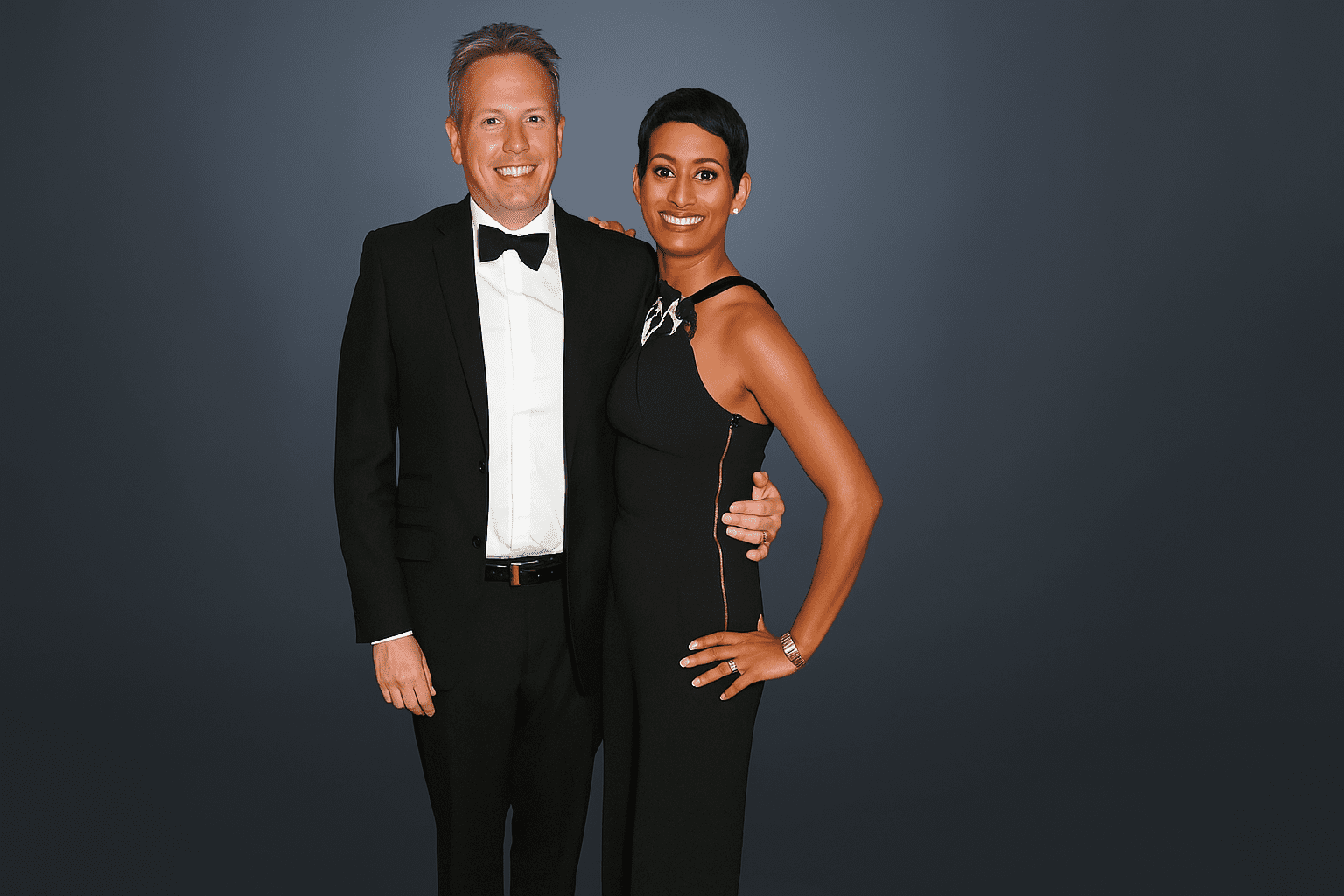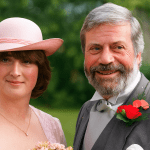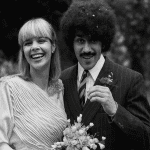In the intricate world of television, where every second counts and every cut must tell a story, directors are the unseen architects of visual storytelling. Among those who have shaped the modern face of British broadcasting, James Haggar stands out as a consummate professional — a director, producer, and studio leader whose influence can be felt across multiple UK television networks.
Known for his dynamic work behind the scenes on programs such as 5 News and Live From Studio Five, and his senior roles across Sky, CNBC, ITV, GB News, and TalkTV, Haggar’s name has become synonymous with precision, creativity, and composure under pressure.
Beyond his technical excellence, Haggar is also recognized as the husband of BBC presenter Naga Munchetty, yet his career stands firmly on its own merit — one built on decades of dedication to the art and science of live broadcasting.
Early Life and the Path to Television
While much of James Haggar’s early biography remains private, what is evident is his deep-rooted passion for media and storytelling. His journey began not in front of the camera, but behind it — a world where details matter, technology evolves daily, and success is often measured in milliseconds.
From his earliest days in broadcast operations, Haggar demonstrated an innate understanding of visual rhythm and timing. The ability to synchronize multiple live feeds, direct presenters naturally, and maintain calm during high-pressure moments set him apart from his peers.
In an industry where errors are instantly visible to millions, Haggar’s precision and consistency quickly earned him trust. That trust translated into opportunities with some of Britain’s leading networks — each one sharpening his creative instincts and leadership acumen.
The Role of a Television Director
To understand Haggar’s importance, it’s essential to grasp what a television director does — particularly in live or studio-based broadcasting.
A director is the orchestra conductor of a television production. He or she coordinates cameras, manages the flow of visuals, communicates with presenters and producers, and ensures that the final product — whether it’s a news broadcast, talk show, or debate program — flows seamlessly from start to finish.
The job requires a rare combination of technical skill and artistic vision:
-
The technical side involves camera angles, lighting, cueing, sound coordination, and switching between feeds.
-
The artistic side is about storytelling — how a camera pan can add emotion, how a cut can amplify tension, and how visual pacing keeps the viewer engaged.
Haggar’s excellence lies in mastering both dimensions. He is widely respected for bringing clarity and structure to chaotic live environments — whether directing a high-profile interview, managing breaking news coverage, or guiding presenters through unexpected on-air developments.
Career Beginnings: Crafting His Style
James Haggar’s career trajectory through British television is marked by steady growth, technical refinement, and leadership roles that reflect both trust and talent.
He began his professional journey in television production during a time when analog systems were giving way to digital workflows. This transitional period demanded adaptability — something Haggar had in abundance. His early exposure to newsroom environments gave him a strong foundation in live direction, camera scripting, and studio management.
By the time he joined Channel 5, Haggar was already a seasoned hand at coordinating live feeds, timing commercial breaks, and orchestrating on-air graphics. At Channel 5, he directed shows that balanced information with entertainment, blending visual tempo with editorial sensibility — an approach that would define his later work.
Channel 5: The Rise of a Studio Director
At Channel 5, James Haggar took on one of his most publicly recognized roles as a studio director. He directed 5 News, the network’s flagship news program, and later worked on Live From Studio Five, a magazine-style show that blended current affairs with entertainment.
These programs demanded versatility. Unlike pre-recorded dramas or documentaries, 5 News required a director capable of reacting in real-time to breaking developments, technical faults, or unexpected guest dynamics. Haggar thrived in that environment.
His colleagues often noted his calm under pressure — a vital trait in the control room where even a few seconds of hesitation can disrupt the broadcast flow. His sense of timing, combined with empathy for presenters and production staff, made him an invaluable leader.
The shows he directed carried a signature look: clean transitions, natural camera framing, and a focus on human connection rather than mechanical precision alone. Viewers might not have known his name, but they felt his influence in every smooth broadcast.
Transition to Sky and CNBC: Expanding Horizons
After Channel 5, Haggar’s career expanded further when he joined Sky and later CNBC, broadening his experience in both general news and financial broadcasting.
At Sky, he worked on panel discussion programs and editorially complex live debates. These programs tested not only technical skills but also emotional intelligence — directing talent with strong personalities, maintaining balanced coverage, and ensuring that each camera movement reflected the tone of the conversation.
At CNBC, he immersed himself in the fast-paced world of financial news. Unlike general news, business channels rely on real-time data visualization, ticker integration, and precision timing synchronized with market openings. Directing in that environment demands exceptional split-second judgment and deep familiarity with newsroom automation systems.
Haggar mastered those tools and workflows, positioning himself as a director who could move seamlessly between different genres — from entertainment panels to economic coverage, from personality-driven segments to corporate programming.
Leadership at GB News and TalkTV
Haggar’s next professional evolution came with his involvement in GB News, and later TalkTV, two networks that emerged as challengers to traditional British news broadcasting.
In both settings, Haggar brought discipline, creativity, and structure to the production process. These channels were characterized by their live, debate-driven formats — the kind that require instant reaction from control rooms and quick visual decision-making.
At TalkTV, Haggar rose to the prominent position of Head of Studio Output. This was not merely a directing role; it was a leadership position overseeing the look, rhythm, and reliability of the network’s live programming.
His responsibilities included:
-
Managing multiple studio teams.
-
Developing standardized workflows.
-
Training and mentoring younger directors.
-
Ensuring consistent visual style across shows.
-
Troubleshooting technical or editorial bottlenecks in real-time.
His appointment as Head of Studio Output was both a recognition of his craft and a signal that TalkTV was investing in stronger production values. Haggar’s role symbolized the channel’s ambition to compete with larger, more established networks while maintaining a modern, agile broadcast identity.
Directing Philosophy: Calm, Precision, and Human Connection
Ask anyone who has worked with a great live director, and they’ll tell you — the best ones never shout. They lead quietly, with precision and confidence. James Haggar embodies this principle.
His directing philosophy rests on three pillars:
1. Calm in Chaos
A control room can be overwhelming — producers shouting updates, technical ops juggling feeds, presenters speaking live. Haggar’s calm demeanor and clear communication style create order out of that chaos. His voice in the gallery becomes the anchor others rely on.
2. Precision in Timing
Every cue, transition, and visual effect in live TV must align perfectly. Haggar’s timing is renowned — his ability to call camera shots half a second before the moment, ensuring every cut feels natural. That precision makes his broadcasts visually smooth and emotionally satisfying.
3. Human Connection
Television, at its heart, is a medium of human stories. Haggar directs with empathy — ensuring that cameras capture authentic reactions, not just faces. His understanding of human rhythm and storytelling transforms ordinary interviews into compelling viewer experiences.
Technical Mastery and Innovation
Over his career, James Haggar has witnessed — and adapted to — several revolutions in broadcasting technology:
-
From Analog to Digital – Transitioning from manual tape decks and switchers to fully digital video servers and automated editing systems.
-
HD and 4K Revolution – Directing in higher resolutions demanded a rethink of camera framing, lighting, and color balance.
-
Virtual Sets and Augmented Graphics – Integrating live data and augmented visuals while maintaining editorial clarity.
-
Remote Production (IP-Based Workflows) – Modern studios increasingly rely on IP transmission, remote guests, and distributed teams — systems that require robust coordination, latency management, and flexibility.
Haggar’s technical fluency ensures that his teams operate with both creativity and control. He is as comfortable discussing MOS workflows and intercom hierarchies as he is storyboarding a live debate or mentoring an assistant director.
His balance of artistic and engineering knowledge makes him a “bridge” between creative producers and technical engineers — an invaluable quality in modern media organizations.
Mentorship and Crew Building
Directors are often judged by their broadcasts, but their legacy is written in the teams they build. Haggar is known for cultivating cohesive studio environments where collaboration replaces hierarchy.
In the gallery, he emphasizes:
-
Preparation: Every crew member, from camera ops to graphics techs, understands the plan before going live.
-
Mutual respect: Mistakes happen — the goal is to fix them together, not assign blame.
-
Continuous learning: Each broadcast becomes a lesson. Airchecks are reviewed, not to criticize, but to improve future output.
By fostering such a culture, Haggar ensures that the quality of production doesn’t depend solely on him. His mentorship philosophy creates resilient crews who can maintain high standards even in his absence — a hallmark of great leadership.
Personal Life and Partnership with Naga Munchetty
Outside of the studio, James Haggar maintains a relatively low public profile. He is married to Naga Munchetty, one of Britain’s most recognized broadcast journalists and presenters.
The couple reportedly married in 2007, and their relationship reflects mutual understanding — both share demanding careers in television, which requires empathy, discipline, and flexibility.
Their marriage has often been described as grounded and private, with both partners preferring to keep personal matters away from public spectacle. They live in Hertfordshire, where they balance professional intensity with quiet personal life.
Although media outlets occasionally highlight their relationship, Haggar’s career accomplishments stand independent of his wife’s fame. Within the broadcast community, he is primarily respected for his craftsmanship, professionalism, and mentorship, not for his celebrity connection.
Inside the Gallery: A Day in James Haggar’s World
To appreciate the scale of his work, imagine a typical day directing a live broadcast under Haggar’s leadership:
-
Morning Briefing: Review scripts, rundown, graphics, and live feed availability. Coordinate with producers and news editors.
-
Rehearsals: Test camera positions, lighting cues, and transitions. Ensure presenters are comfortable with teleprompters and visual aids.
-
Live Broadcast: Direct in real time, calling camera shots (“Camera 2, ready… take 2”), timing cues for transitions, and adjusting to breaking updates.
-
Post-Show Review: Conduct an aircheck session — discuss what worked, what needs improvement, and how the next show can be tighter.
-
Technical Calibration: Coordinate with engineers to troubleshoot any broadcast delays, sync errors, or sound balance issues.
Such precision and discipline are the backbone of any successful studio — and Haggar’s control rooms are known for running like well-oiled machines.
James Haggar’s Legacy in Modern British Television
Over two decades, Haggar has contributed to shaping the grammar of British live television. His career represents a bridge between the traditional era of scheduled broadcast and the digital-first ecosystem of today.
Some hallmarks of his legacy include:
-
Elevating production values at emerging networks like TalkTV and GB News.
-
Maintaining professionalism through the unpredictable chaos of live television.
-
Mentoring a generation of new directors and control room staff.
-
Blending editorial sensitivity with technological fluency.
He belongs to a rare class of directors who have managed to evolve with the industry — adapting to every shift, from analog cameras to cloud-based control rooms, without losing sight of what television truly is: storytelling through motion.
Philosophy on Storytelling and Audience Trust
In the age of streaming, social media, and fragmented attention, live television remains one of the few shared experiences. Haggar understands that trust and authenticity matter more than spectacle.
His directing style prioritizes truthful moments:
-
When a presenter’s emotion breaks through during a difficult story.
-
When silence communicates more than any headline.
-
When visual rhythm enhances understanding rather than distraction.
These nuances are why his broadcasts resonate. They’re not just technically perfect — they’re emotionally coherent.
Challenges of Modern Broadcasting
As media landscapes evolve, directors like Haggar face new challenges:
-
Multi-platform distribution: Shows must look good on both TV and mobile screens.
-
Time compression: Editing and direction are faster, tighter, and more reactive than ever.
-
Audience skepticism: Viewers expect transparency and authenticity, not over-polished production.
-
Technical overload: Directors now manage dozens of visual sources, remote guests, and live feeds simultaneously.
Haggar’s leadership approach — rooted in simplicity, teamwork, and adaptability — makes him uniquely capable of navigating these challenges. His career is proof that timeless principles like clarity, preparation, and empathy never go out of style.
Advice to Aspiring Directors
For those who dream of becoming television directors, James Haggar’s career offers several lessons:
-
Master the basics. Before you innovate, learn timing, framing, and communication.
-
Stay calm under pressure. A director’s tone shapes the entire control room.
-
Embrace technology, but don’t let it dominate. Tools change — storytelling doesn’t.
-
Respect every crew member. Great television is a team effort.
-
Learn from every mistake. Airchecks are the classroom of real-world television.
-
Balance creative flair with discipline. Improvisation must be backed by structure.
Beyond Television: The Broader Impact
James Haggar’s work extends beyond television. As live production workflows influence streaming, corporate events, and social media broadcasts, his approach to directing — clean visuals, human focus, technical mastery — serves as a template for modern multimedia storytelling.
Whether it’s a YouTube live stream, a political debate, or a corporate webcast, the DNA of Haggar-style direction — order, empathy, precision — is now visible everywhere. His career exemplifies how traditional broadcast craftsmanship continues to inform the next generation of visual communication.
Conclusion
James Haggar represents the best of British television professionalism — a figure who thrives not on celebrity, but on craft. His story is not one of overnight fame, but of long-term mastery — a man who learned the rhythms of live broadcasting, adapted to technological revolutions, and rose to become a leader in one of the world’s most demanding creative industries.
Behind every seamless newscast, every polished talk show, and every perfectly timed cut, there’s a team led by someone like Haggar — a steady hand in the storm.
He may not be the face viewers recognize, but he is the reason their screens stay alive with meaning, rhythm, and trust.










